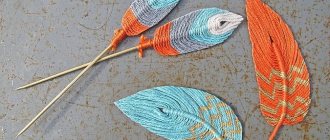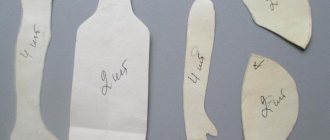In modern craft stores there are quite a lot of goods for scrapbooking. Therefore, it will not be difficult to understand how to make a diary with your own hands at home. A homemade diary can be an excellent gift or brighten up a master’s work or school routine.
You can make your own either simple notebooks of several pages in a small format or full-fledged bound diaries. In any case, this is a rather labor-intensive process that requires patience and attention. The master class will tell you about several ways to assemble a diary and suggest options for its design and decoration.
DIY diary from a finished notebook: description, photo
The first thing that comes to mind is processing an existing notebook. How can this be done? Get creative by creating a diary with a clock from the most ordinary old notebook !
Besides the fact that this will be quite unusual, it will also be very useful for people who are constantly late. Now, when planning any event or checking with those closest to you, the owner of this useful notebook will always be able to know what time it is.
The manufacturing procedure is as follows:
- You need to take an old wristwatch, which, however, will be in working order. It is preferable to remove the watch strap.
- This clock is attached to the inside of the bottom cover. It is most convenient to use glue.
- All that remains is to make slits on all the pages that will correspond to the circumference of the dial. This way, no matter which page you turn, the clock will always be visible.
IMPORTANT: This part of the manufacture is the most difficult. To make it go perfectly, it is better to use a stationery knife.
This is how a personalized diary with a clock can turn out from the most ordinary notebook.
Active individuals can make a thick diary from several notebooks. For this you will need:
- Actually, several notebooks
- Satin ribbon, preferably thinner
- Good density white cardboard
- Hole punch, scissors
- Simple pencil and markers
- Ruler
- Various decorative elements - for example, stickers, multi-colored tape
The diary is prepared as follows:
- Notebooks are getting rid of covers. This is easiest to do with paperback notebooks that are not too thick.
- Next, using a hole punch, holes are made on the spines of the notebooks
IMPORTANT: The holes must be made in such a way that the notebooks can then be conveniently fastened together. That is, parallel to each other.
- Then the notebooks are folded spine to spine
- through the holes made and tied
- two parts from thick cardboard that will represent the cover.
- These parts are placed on opposite sides of the notebooks and connected to each other in the same way using tapes
- All that remains is to decorate the cover according to your personal wishes.
This is what a diary assembled from several notebooks might look like
What can the product be made from?
Naturally, the materials from which the notebook will be made are also necessary. Most often, diaries are made from standard office paper in A4 or A5 format. It all depends on how thick the notebook will be and how often it will be used. Most often a small diary in A5 format.
If you do not have such paper, then you can cut standard sheets into two parts. In addition, you can use regular notebooks with a square or ruler. In this case, you will have a simple notepad. If you need a book with specified dates, then it is better to print this information on white sheets.
You can use packaging cardboard to make the cover. It has high density. Cardboard is usually covered with wrapping paper. You can decorate the cover in different ways. It all depends on your imagination.
DIY diary on rings: description, photo
Many people like this type of diary. They are beautiful and practical. To create such a thing you will need:
- Binding cardboard
- Thick paper - perfect for scrapbooking
- The rings are detachable - they are also quite easy to purchase separately
- Awl
- PVA glue
- Sewing machine, scissors
- Printer required
IMPORTANT: And even better - a special device for installing eyelets.
The manufacturing process is simple:
- Using the printer, blank pages for the diary are printed. Or you can mark it yourself on attractive scrapbooking sheets.
- The sheets are equal.
- For the cover, sheets are cut out of cardboard to suit the format of the future diary.
- The cover is covered with colored paper. Scrap paper is also appropriate here.
- After combining the cardboard and the main sheets, are made .
IMPORTANT: It is preferable to insert grommets - this step will help keep the cover intact for a long time.
- All that remains is to insert the rings.
You can get such a cute diary on rings.
You can also create an unusual diary with a cover that imitates wood. You will need:
- Metal rings with connectors
- Metal corners in the amount of 4 pcs.
- Thicker cardboard
- Acrylic paints - need 2 shades
- Craquelure varnish
- Stationery knife, awl, pliers, scissors
- Ruler, pencil
- Flat synthetic brush
- Paper
The paper for the diary can be anything, even colored and with drawings. The rings and corners for the diary are needed like this.
You can start making:
- To begin with, regular and cardboard sheets are equal. Cardboard ones can be slightly larger, since they will make a cover.
- Next, symmetrical holes are made in the cardboard
- The cardboard is coated with acrylic paint. After this it becomes quite dense, so it is recommended to level it before coating.
IMPORTANT: Several layers are needed to artificially age the cover. If you just plan to decorate it with drawings, you can get by with just one.
- Both the outer sides of the future cover and the inner ones are painted.
- If you still need to trim the cardboard, you should lay something under the table.
- After applying the first coat of paint, it should be allowed to dry thoroughly .
- Next is the turn of craquelure varnish. To make it dry faster, you can use a hair dryer.
- And again a layer of paint. The master must remember that the direction of movement of the brush is actually the direction of future cracks.
You get the following blanks for the cover of your diary:
- But now you can attach the corners. If it is difficult to do this with your fingers, pliers will come to the rescue.
- If necessary, you can once again put the pages of the future diary in order.
- All that remains is to put everything together, fasten it with rings - and now the vintage diary is ready!
This is the vintage diary on rings you can get in the end
November 30, 2018
Evgenia Artemyeva Managing editor of the online magazine “Owner”, a creative personality and a happy person. I love to write, look at the sky and introduce good people to each other. I believe that for happiness you already have everything, you just need to take a close look at your inner world.
- vk.com/evartemeva
This article was my response to the challenge posed to the participants of the #vovremya project.
After Sergei Khramov’s article “In search of the ideal diary in the style of #vovremya,” I also got excited about the idea of creating a convenient and suitable planning tool for me.
The thing is, I'm a freelancer. I work as a journalist, in addition to this I am developing two more Internet projects. So my schedule is not consistent. Sometimes you have to get up at four in the morning Vladivostok time to listen to a webinar by a Moscow trainer, and on another day sleep until lunch.
This leaves an imprint on my business planning scheme. Naturally, standard diaries designed for a working day from nine to six do not suit me. So I used my favorite principle: “If you want what you don’t have, do it yourself.”
All tasks of the #vovremya project can be viewed here.
Strategic cardboard
I borrowed the term from Sergei Khramov, the ideologist of the #vovremya project.
It's a really hard piece of cardboard that I write down strategic goals on. So they are always before my eyes, and I don’t forget about them in the bustle of daily worries.
General plan for the month
It is a plate with three dozen cells, giving a general idea of the events of the month.
Thanks to this sign, I remember birthdays, deadlines, payments.
Weekly planner
It’s also a sign, but on it I write down those things that I can’t forget about.
Daily planning forms
The idea of this form belongs to Dmitry Litvak and is described in detail on his blog.
In my opinion, this is one of the most advanced day planning tools. At least from those that I have encountered.
Let's look at an example of a form with marked areas :
In this table I write down things that are tied to a specific time. Some take several hours, others a minute. For example, a short phone call. But if the task starts strictly at 15.00, then it goes to this section. He has:
Column for indicating the exact start time of the task.
A time of day map, similar to a Gantt chart, is an incredibly convenient planning tool. On the line I write the matter of the day. In the box for the corresponding hour, I mark when it needs to be done. A huge convenience is that you don’t have to squeeze in a new task for 11.00 between 10.30 and 11.30. I write it at the very bottom of the list, and draw a circle in the time box. Thus, scanning the day card from left to right, I clearly see what and when I have planned. And on the drum where it was recorded. By the way, the tails in front of the circles mean that I will need time to travel. Or before the meeting, just in case, you should call and clarify whether it will definitely take place.
What I love about my paper organizer is the ability to transfer tasks. The task itself is still there, only time changes. Try repeating this trick on a classic sheet of paper!
To-do list area. Here I am writing something that has no time reference. Can be grouped according to different criteria. For example, it is convenient to have telephone calls in one group, or to combine them by territorial affiliation: “Office”, “Bank”, “Mail”, “ABS Company” and so on.
Free notes area.
Daily checklist. Contains nine stable task elements, the completion of which is marked with a tick. For example, “Marathon task completed”, “Daily report completed” and other things that I, for example, want to make my habit (“Face exercises”, “Morning pages”, “Ten minutes meditation” and so on). When it becomes a habit, I simply change the form.
Daily report
On the back of my daily planning sheet, I have included a form with questions to help me evaluate the quality of my day.
I learned this technique at the Mutual Awareness Marathon, which took place in January. Here are the questions I ask myself every night before going to bed:
- What did I do for my dream?
- The main achievement of the day. This question helps me evaluate whether I really concentrated on what was important during the day? Or did you waste time on routine?
- CMU (what could be improved). I analyze my mistakes and overall performance. As they say, don't be afraid to make mistakes, don't be afraid to make them twice.
- The insight of the day is what amazed me. It could be a thought, a book, a person, an event, in general, anything that makes my life brighter and more meaningful.
- Conclusion of the day . Here I evaluate my entire day from the standpoint of efficiency and positive emotions. I note what to focus on in the future, and what can be done in between.
ProPoPnu (check-praise-kick)
I also got this invention at the Mutual Awareness Marathon.
The PoProPnu table consists of two parts - a column with tasks or habits that I would like to do daily, and a calendar.
In the boxes of the days, I check off the fact that the task has been completed.
Ideally, I should get thirty ticks in a month, then I will receive encouragement. If there are fewer checkboxes, I punish myself.
In addition, the PoProPnu sign allows you to track the dynamics of movement towards the goal in time.
If I miss a scheduled task more than twice, this is a reason to think: am I going in the right direction?
Maybe you should reduce your workload or reconsider your priorities? Or is this not my goal at all, and I actually want something else?
In a word, this is a reason to once again evaluate the importance of the result and the necessary resources, adjust the plan and move on.
Ideanik
This is a section of the diary with blank pages where I write down thoughts, synopses of articles, notes.
Recently, not only recordings, but also sketches have begun to appear in it.
Mike Rowdy's book Visual Notes opened my eyes to the idea that thoughts can not only be written down, but also sketched.
I really like both the process itself and the cool, schematic pictures, which are much easier to understand than regular notes.
Additional sections
Post pages
This is analogous to a notepad where I write down information after telephone conversations, business meetings, etc.
- Archive
I carry with me a small version of the diary - a strategic cardboard, a monthly plan for the current period, a weekly plan, seven sheets of the diary, two or three sheets of an idea book and two or three sheets for notes.
The rest, like the sheets from the past weeks, is stored in the archive. This is the second notebook on rings, where the written sheets migrate on Sundays.
Where to start creating your ideal diary
- Choose a convenient medium. Let it be a notebook that you really like. For myself, I chose a ring notebook with a hard cover. It is easy to change sheets, and the A5 format suited me perfectly. You can treat yourself to a stylish Moleskine or create your own notebook; fortunately, there are plenty of master classes on bookbinding and cover decoration online.
- Analyze what communication gaps exist in your life over time. Maybe you lack focus on strategically important goals? Or do you forget to buy groceries and call your mom in the daily bustle? Write all these items down on a separate list and move on to tip #3.
- Think about why previous diaries didn’t suit you , what you were missing in them. For example, I always lacked space for notes and lists, an envelope for small items. By the middle of the year, all my diaries were swelling to incredible volumes due to the abundance of pieces of paper inserted into them, pinned and glued. Now I keep all these “needs” in the archives.
- Look through existing diaries . You can start with the article “Professional diaries: so different, so necessary”; some of the templates given in it are very good. You don’t have to copy them exactly, just take some elements. For example, the lines “Clean up the tails” or “First hour of work” can greatly move you towards your goals.
- Write down which planning tools you use , and which inventions of time management gurus you are thinking of implementing. Then create your own entry pages based on them. You can type them up in any editor; I advise the laziest to look for templates on the Internet.
- Print your pages on a printer or printing house, sew them together and your ideal diary is ready!
Quote on Twitter
The ideal diary does exist. Only it is different for everyone, and one must put effort and imagination into its appearance.
Want to figure out your goals? Do this in the Stodnevka project - an expedition to a new self
Registration for Stodnevka is open, which starts on MARCH 1. Details here
One hundred days is an environment for development. By immersing yourself in it, in 100 days you can not only achieve your goal, but also understand yourself, clarify your values, learn to enjoy life here and now, and not someday, when your desires come true.
You don't have to put in extra effort. The rule of small steps helps you move towards your goals calmly and continuously.
- The author and presenter of the course is Armen Petrosyan.
- The work takes place in a team of like-minded people on a closed site where only group members have access.
- At the moment, there are already 3633 participants in the project, most of them have completed Stodnevka more than once.
- Stodnevka tools - freewriting, working with a daily plan, habit tracking, lists, journaling and much more.
- Having paid for the course once, you get the right to take the Stodnevka as many times as you like.
- Find out details
- Sign up for a course
- View an example of a letter with a task
- Listen to a free introductory webinar for one of the groups
- Read member stories
Self-development #Diaries #Tools #Planning
DIY diary book: description, photo
If you want to create a hand-bound diary booklet, you will have to stock up on the following components:
- Cardboard
- Sheets corresponding to A4 format
- Fabric and fabric ribbon
- A piece of gauze
- PVA glue
- Marker
- Needle and thick thread
IMPORTANT: You need thick sheets, thin sheets will not work.
The diary is prepared as follows:
- First of all, sheets of A-4 format are folded in half.
- From them you need to form a kind of notebooks, nesting them in each other. Each notebook can hold from 2 to 5 sheets.
- These notebooks are folded into one pile and left under pressure for some time . Special office clips and sheets of cardboard that protect from marks will help with this.
A diary in the form of a book needs to press leaves according to this principle
IMPORTANT: Leave the sheets in this position for at least 3 hours.
- After the specified time, the staples can be removed.
- cut off several strips from the fabric tape . with them .
Fabric strips are applied to the future diary like this:
- But there is no need to attach the strips at this stage - after marking the locations of the strips with a pen or pencil, they can be removed.
Marks on the future diary It is even more convenient to make these slits on the future diary
- Now the fabric strips are taken again, but this time they are sewn firmly to the workpiece . Please refer to the photographs below. It is worth noting that you do not need to sew the entire stack to the ribbons at once - each notebook is processed separately.
The stripes are applied to the future diary first like this. Then the stripes are attached to the future diary with loops of thread like this. Now it’s time to sew on the second notebook of the diary. This is how the notebooks for the diary are attached. Now you can sew on the third notebook of the diary. This is how the weave of the diary will turn out
- The spine needs strengthening . To do this, you need to put gauze on it under a press. Or use sealant.
The gauze should be placed on the diary like this
- Next, the spine is covered with fabric tape.
The diary spine meets the fabric tape again
- Now 3 parts are cut out of thick cardboard - the spine and parts of the future cover.
IMPORTANT: It should be remembered that the cover should be slightly larger than the sheets.
- rectangular piece out of the fabric on which the blanks described above can be placed.
- They need to be glued to the fabric.
Cardboard blanks and fabric cover for the future diary
- The remaining unoccupied parts of the cover are glued with pieces of fabric from the inside.
Gluing the inside of a diary cover with fabric
- Now the flyleaf is glued on.
This is what the endpaper for a diary looks like
- All that remains is to connect the main part of the leaves and the cover.
It turns out this is a diary-book
DIY scrapbooking diary: photos, description
You can also make a wonderful diary with your own hands with a bright, unusual cover. For this you will need:
- Scrap paper
- Any other sheets
IMPORTANT: In this case, there is a rule that the more unusual the paper, the better. That is, old sheet music, unnecessary packaging from something, etc. can be used.
- High-density cardboard or special blanks for covers Album rings
- Glue gun, double-sided tape, stamp pad
- Scissors, hole punch, sewing machine
- Ribbons
You can start making:
- First of all, it’s worth calculating in advance what design is best for the diary. Then, based on this, you need to cut off the preferred number of ribbons in advance and prepare the required amount of other decor.
- The machine will help you sew the necessary parts onto the paper.
The machine is very convenient for processing blanks for a future diary. This is what the seams look like from the inside of a blank for a diary.
- Double-sided tape is attached to the cardboard that processed paper with decor can be glued onto it.
This is how you need to paste over cardboard for the cover of a diary
- But, despite the presence of adhesive tape, additional processing of the cover clearly would not hurt. That is, it is advisable to stitch it around the perimeter.
IMPORTANT: A wide stitch is best for this.
This is how you can stitch the edges of a future diary cover
- Now you can glue any other decorative elements.
Any decor will make the diary unique
- To make the pages of your future diary attractive, you can mark them with a stamp pad.
A stamp pad will decorate the pages of your diary.
- Next, using a hole punch, punctures are made in the sheets - and you can connect all the sheets and parts of the cover.
This is how the parts of the diary are connected. It turns out to be such a wonderful diary that you will want to fill out every day
How to draw the inside of a diary: ideas, photos
How can you conveniently design a diary from the inside? We offer several ideas as options:
Each day in the diary can be indicated by a square in which plans are entered. You can simply select a page for each day in the diary, and write things in a column. To-dos in the diary can be distributed not only by day, but also by category. You can also paste similar tear-off leaves into the diary , which are removed as the next goal for the day is completed. You can combine day cells in the diary with tear-off leaves and a separate list of goals. This kind of layout of the diary is very convenient not only by days of the week, but also by hours
Not to do list
bulletjournal.com
How to keep a diary
The method was created in order to learn how to prioritize and manage to do the most important thing. All tasks are divided into three lists: to-dos, completed to-dos and not to-dos. You can add only three points to the first one, no more. Other activities are considered not so important and end up on the not-to-do list.
The completed task from the first column must be moved to the second. This, by the way, increases How Checklists Train Your Brain To Be More Productive And Goal-Oriented dopamine levels, and with it productivity. Space is freed up in the to-do list for a new activity, which can be moved there from the third group.
What are the advantages
- The system helps you figure out which tasks are really important and which can be left for later.
- The method is very simple and convenient, suitable even for beginners in planning.
What are the disadvantages
- Some tasks may get lost in the to-do list and remain unfulfilled.
- For those who like to structure everything, such notes may seem too chaotic.
Making a diary with your own hands: ideas, photos
Now let’s offer options for the external design of the diary:
Personalized diary with buttons Old notes or old newspaper clippings will give the diary a vintage feel Metal details will give the diary style An envelope diary is a laconic and convenient model You can sew applications from various fabrics to the diary The status that appears on the cover of the diary will add optimism every time you use it This is so interesting retro idea for designing a diary You can sew a zipper into the diary and make pockets - it’s convenient to put pens, pencils, business cards, and a calculator there. Decoupage of the diary will help you create an interesting design. Anything can be used to decorate the diary - braid, old photos or pictures, buttons, ribbons Beads of various sizes will give the appearance of the diary a special chic Delicate design of the diary made of buttons and braid
Nowadays you can find a diary for every taste on sale. But why not create it for yourself? Unique, uplifting, motivating. One in which you will definitely want to make notes. I would like to hope that the tips in this article will help with this.
Simple option
If you don’t want to spend a lot of time doing the work, you should choose a simple master class. It turns out that you can make a notebook in a few minutes. Children will especially like the product.
Materials:
- glue;
- paper;
- threads;
- cardboard.
Execution sequence:
- We bend the sheets in half.
- Place the paper on the cover.
- We sew the product on a sewing machine or by hand.
- We decorate the notebook at our discretion.
The product will be original and quite attractive. And most importantly, it can be done without difficulty - even a beginner can cope with the task.











